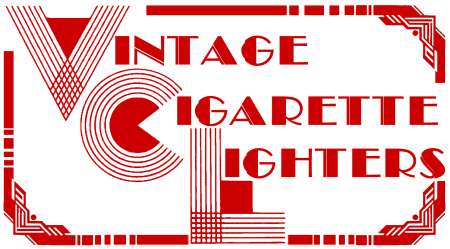|
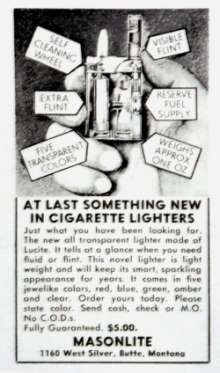 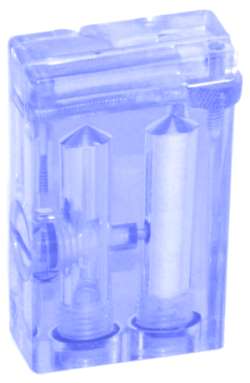 Most lighter collectors are not familiar with the name Homer Mason. He only invented one lighter but his “Masonlite” will soon become one of the most important pocket lighters of the post ww2 era. His idea of the visible fuel supply in 1946 was ahead of its time. It was the forerunner to future American vu lighters manufactured by Ritepoint in 1947 - Video in 1948 –Duo liter in 1949 and Scripto in 1956. These other visible tank lighters incorporated metal plated mechanisms while the Masonlite is the only all Lucite pocket lighter and featured a modern industrial dual fuel chamber design. Most lighter collectors are not familiar with the name Homer Mason. He only invented one lighter but his “Masonlite” will soon become one of the most important pocket lighters of the post ww2 era. His idea of the visible fuel supply in 1946 was ahead of its time. It was the forerunner to future American vu lighters manufactured by Ritepoint in 1947 - Video in 1948 –Duo liter in 1949 and Scripto in 1956. These other visible tank lighters incorporated metal plated mechanisms while the Masonlite is the only all Lucite pocket lighter and featured a modern industrial dual fuel chamber design.
The Masonlite came in 5 jewel colors including – ruby – topaz – emerald – sapphire and diamond. The wholesale cost was $1.95. The Masonlite was precision made of heat resistant Lucite making it lightweight weighing less than 1 ounce. The spark wheel was made of hard steel and self cleaning. The fuel screws have special gaskets making the lighter leak-proof. The Masonlite also features an unusual fuel system having side screw operation to transfer fuel from reserve tank to wick chamber. Homer describes the Masonlite in the instruction booklet as “more than a match” and “a jewel among lighters”. Collectors will certainly agree once they own one.
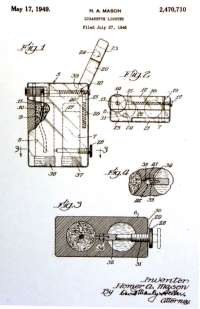 Homer Alton Mason one of 13 children was born January 17,1916 in Ironton, Wisconsin. He left school during 3rd grade to help his mother and older brothers support the large family. His father had died during the flu epidemic of 1919. Homer moved to Chicago in the mid 1930’s doing various jobs including chef and apartment janitor until he went to work for International Harvester. At IH - Homer invented a long hinge for their refrigerator door and he received a nice payment. In Chicago, Homer met his future bride Anita Evelyn Anderson and they married on September .2, 1939. When the war started for America in 1941, Homer was 25 but felt his responsibility to volunteer and quickly joined the U.S. Marine Corps. After training in San Diego, Homer went overseas for 3 years. He fought in the pacific theater as part of a tank crew where his mechanical abilities were vital to drive and repair tanks. Homer was part of the Iwo Jima and Guadalcanal campaigns. His service during those wartime years makes Homer a true war hero. Homer Alton Mason one of 13 children was born January 17,1916 in Ironton, Wisconsin. He left school during 3rd grade to help his mother and older brothers support the large family. His father had died during the flu epidemic of 1919. Homer moved to Chicago in the mid 1930’s doing various jobs including chef and apartment janitor until he went to work for International Harvester. At IH - Homer invented a long hinge for their refrigerator door and he received a nice payment. In Chicago, Homer met his future bride Anita Evelyn Anderson and they married on September .2, 1939. When the war started for America in 1941, Homer was 25 but felt his responsibility to volunteer and quickly joined the U.S. Marine Corps. After training in San Diego, Homer went overseas for 3 years. He fought in the pacific theater as part of a tank crew where his mechanical abilities were vital to drive and repair tanks. Homer was part of the Iwo Jima and Guadalcanal campaigns. His service during those wartime years makes Homer a true war hero.
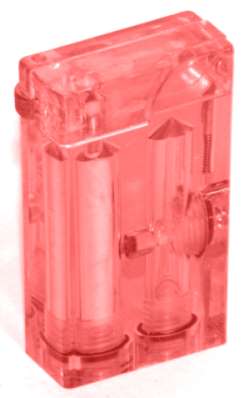 After the war - Homer went back to work for International Harvester. As did many servicemen - Homer also came back from the war with a novel idea for a cigarette lighter. In 1946 Homer designed a clear visible fuel tank lighter and submitted his design to the U.S. patent office. However - Homer did not manufacture his creation for a few years as he did not have the finances. Homer then heard of the need for copper miners so he moved to Butte, Montana in 1949. In the Montana wilderness, Homer came to love the mountains, fishing & hunting. But he knew he did not want to mine forever as it was grueling work. Being personable - he felt he could sell insurance. Homer joined the Treasure State insurance business in Butte and his charismatic personality made him very successful. Homer sold Evel Knievel’s father Evel's first life insurance policy and received numerous awards for selling. At this point in his life, Homer had the finances to manufacture his dream lighter. Homer had received US patent # 2470710 in 1949 for his unique lighter invention. Homer then had a machine made to manufacture the lighters. The “lighter machine” was in Homer’s basement where Homer and his eldest daughter – Ann would manufacture the Lucite lighters. They would let the colorful plastic bodies cool - machine drill fuel tanks – then add cotton and screws and package the lighters. Masonlite incorporated in 1950 and became a small hand machined operation with Homer its best salesman. Homer would set up his sales display at all the tobacco shops and bars in Butte and other local Montana towns. Homer never had nationwide distribution making the Masonlite a rare lighter. As Homer was building his business acumen - Butte mining was in decline and Homer was known to help out displaced miners with money – groceries and a free lighter. After the war - Homer went back to work for International Harvester. As did many servicemen - Homer also came back from the war with a novel idea for a cigarette lighter. In 1946 Homer designed a clear visible fuel tank lighter and submitted his design to the U.S. patent office. However - Homer did not manufacture his creation for a few years as he did not have the finances. Homer then heard of the need for copper miners so he moved to Butte, Montana in 1949. In the Montana wilderness, Homer came to love the mountains, fishing & hunting. But he knew he did not want to mine forever as it was grueling work. Being personable - he felt he could sell insurance. Homer joined the Treasure State insurance business in Butte and his charismatic personality made him very successful. Homer sold Evel Knievel’s father Evel's first life insurance policy and received numerous awards for selling. At this point in his life, Homer had the finances to manufacture his dream lighter. Homer had received US patent # 2470710 in 1949 for his unique lighter invention. Homer then had a machine made to manufacture the lighters. The “lighter machine” was in Homer’s basement where Homer and his eldest daughter – Ann would manufacture the Lucite lighters. They would let the colorful plastic bodies cool - machine drill fuel tanks – then add cotton and screws and package the lighters. Masonlite incorporated in 1950 and became a small hand machined operation with Homer its best salesman. Homer would set up his sales display at all the tobacco shops and bars in Butte and other local Montana towns. Homer never had nationwide distribution making the Masonlite a rare lighter. As Homer was building his business acumen - Butte mining was in decline and Homer was known to help out displaced miners with money – groceries and a free lighter.
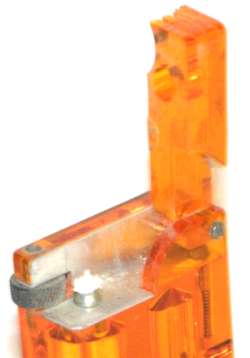 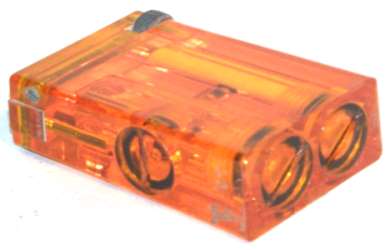 Homers next dream was to open his own insurance company. Well known and trustworthy -he had many financial backers and started the GLACIER LIFE INSURANCE COMPANY in Missoula, Montana about 1961. He bought a movie theater in Missoula to live in which was great fun for his 2 daughters-Anita and Ann. Homer became very successful in the insurance business and spent much of his free time toiling the dirt in his well publicized garden. Homer also collected antique office equipment. Homer passed away suddenly on Aug.3, 1973 from a heart attack. Homer devoted his life to family – business – community and helping others in need - making him a true American hero. Homers next dream was to open his own insurance company. Well known and trustworthy -he had many financial backers and started the GLACIER LIFE INSURANCE COMPANY in Missoula, Montana about 1961. He bought a movie theater in Missoula to live in which was great fun for his 2 daughters-Anita and Ann. Homer became very successful in the insurance business and spent much of his free time toiling the dirt in his well publicized garden. Homer also collected antique office equipment. Homer passed away suddenly on Aug.3, 1973 from a heart attack. Homer devoted his life to family – business – community and helping others in need - making him a true American hero.
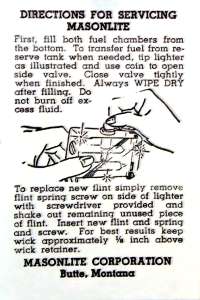 Homer did not live to see the birth of organized lighter collecting. Today’s collectors are finicky about the brands they collect but serious collectors will all desire at least one Masonlite – [if not one of each color]. With Homers combination of machine age modern design and his brilliant idea for a clear Lucite vu lighter that shows fuel capacity – Homer’s invention will live on in the numerous collections of vintage lighters – Modernism and Lucite plastic. Homer did not live to see the birth of organized lighter collecting. Today’s collectors are finicky about the brands they collect but serious collectors will all desire at least one Masonlite – [if not one of each color]. With Homers combination of machine age modern design and his brilliant idea for a clear Lucite vu lighter that shows fuel capacity – Homer’s invention will live on in the numerous collections of vintage lighters – Modernism and Lucite plastic.
The Masonlite is one of the most unique American pocket lighters ever produced. The Masonlite is one of my favorite pocket lighters and writing this article was a labor of love. Thank you Homer from all the collectors who appreciate your talent and desire to invent and manufacture this “jewel among lighters”.
Photos by Larry Tolkin
|
